|
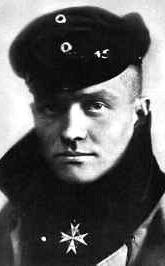 3 Squadron AFC and 'The Red Baron', Manfred von Richthofen
3 Squadron AFC and 'The Red Baron', Manfred von Richthofen3 Squadron was formed at Point Cook, Victoria, in September 1916 and moved to England for training before deploying to France the following year. 3 Squadron aircraft were used for bombing and reconnaissance missions in support of British, Canadian and ANZAC forces and by the end of hostilities the unit was regarded as the best allied reconnaissance squadron of the war.
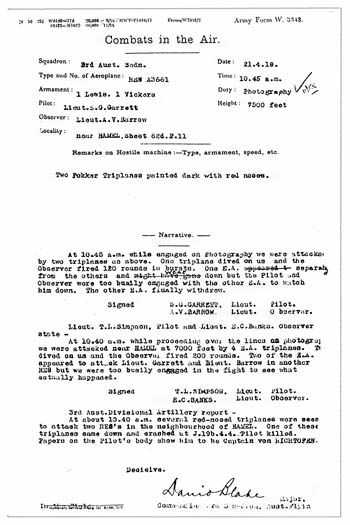 Combat report made out by Garrett and Simpson after the action with von Richthofen and Jasta 11 Franks, N., and Bennett Alan, The Red Baron's Last Flight A Mystery Investigated, Pan Macmillan 1998. You may wish to download a 1000 pixel version of this image
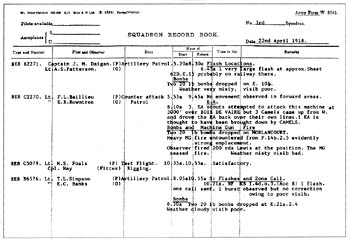 Record Book entry for April 22, 1918 detailing flights of John Daigan (sic. Duigan) and his cousin T. Leigh Simpson Franks, N., and Bennett Alan, The Red Baron's Last Flight A Mystery Investigated, Pan Macmillan 1998. You may wish to download a 1000 pixel version of this image
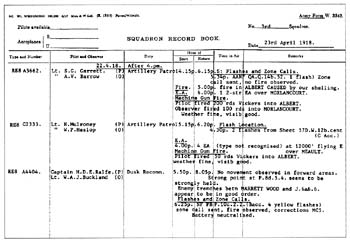 Record Book entry for April 22, 1918 detailing flights of John Daigan (sic. Duigan) and his cousin T. Leigh Simpson Franks, N., and Bennett Alan, The Red Baron's Last Flight A Mystery Investigated, Pan Macmillan 1998. You may wish to download a 1000 pixel version of this image
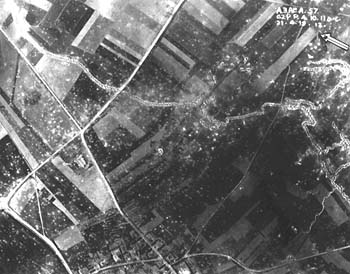
Aerial photo by member of 3 Squadron at about 10.40 a.m. April 21, 1918 Franks, N., and Bennett Alan, The Red Baron's Last Flight A Mystery Investigated, Pan Macmillan 1998. You may wish to download a 500 pixel, 1000 pixel or 2000 pixel version of this image
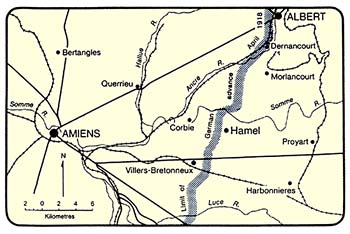 Map of the Amiens-Hamel region April, 1918 http://www.awm.gov.au/1918/battles/hamel.htm You may wish to download a 500 pixel, 1000 pixel or 2000 pixel version of this image
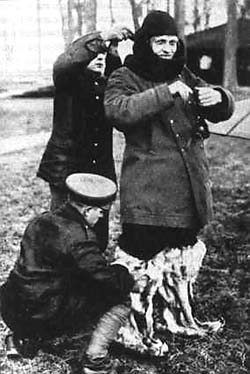 The last known 'portrait' of Manfred von Richthofen If this is as stated in many reproductions, to be the last photo of von Richthofen, then it most probably was taken about 10 a.m., 21 April, 1918. The flying boots seen in the above image are now preserved at the Australian War Memorial. There is also one other 'last image' (not reproduced here) which has von Richthofen in the cockpit of his Dr1 prior to take off on April 21, 1918 however his face is not visable http://www.geocities.com/aw3aw3/archive.htm
Looking for easier pickings the von Richthofen made the mistake of descending to low level over the ANZAC front line, where he was shot down and killed. Debate still rages over who actually shot down von Richthofen was it from the air or from the ground? Two of the contenders for the claim were Australians Cedric Popkin and Robert Buie manning Lewis Guns set up for anti aircraft use. Their claim is extensively examined in Franks and Bennett's The Red Baron's Last Flight A Mystery Investigated, Pan Macmillan, 1998.
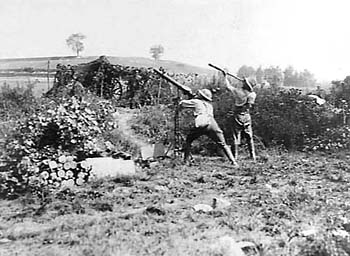 Lewis Gunner of the 30th Battery of Australian Field Artillery engaging enemy aircraft flying over Mericourt, France, on 23 August, 1918 http://www.awm.gov.au/1918/technology/index.htm You may wish to download a 500 pixel version of this image
von Richthofen's body was subsequently recovered by 3 Squadron and buried with full military honours at Bertangles Cemetery near Amiens.
Recent eMails from one George Marshall, (June, 2001) fill in several more details about von Richthofen's funeral and interrement. "(The the Padre taking the service) was my father, the Reverend George H. Marshall D.S.O. He was attached to 101 Squadron R.A.F, who were (stationed) at Bertangles aerodrome at the time, and as von Richtofen was Protestant and my father was the nearest C.of E. Chaplain, he was detailed to take the Funeral." The Reverend George H. Marshall D.S.O.
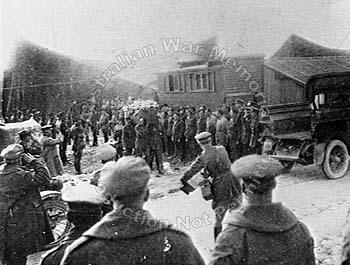 The journey starts : 3 Squadron lays to rest an old adversary, Bertangles Cemetery, France, 22 April 1918 Photo: Sergeant John Alexander, official 3 Squadron photographer. Australian War Memorial Negative Number: P00073.001. Donor: J. Alexander You may wish to download a 500 pixel or 750 pixel version of this image
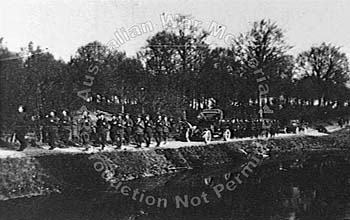 Funeral Cortege : 3 Squadron lays to rest an old adversary, Bertangles Cemetery, France, 22 April 1918 Photographer unknown; Australian War Memorial Negative No. P01034.057, Donor S. Clerehan You may wish to download a 500 pixel version of this image
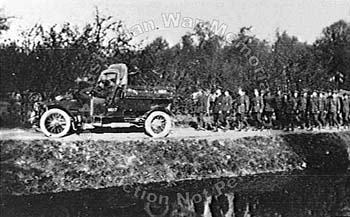 Funeral Cortege : 3 Squadron lays to rest an old adversary, Bertangles Cemetery, France, 22 April 1918 Photographer unknown; Australian War Memorial Negative No. P01034.058, Donor S. Clerehan You may wish to download a 500 pixel version of this image
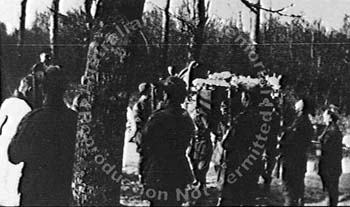 Arriving at the Cemetery : 3 Squadron lays to rest an old adversary, Bertangles Cemetery, France, 22 April 1918 Photographer unknown; Australian War Memorial Negative No. P01034.059, Donor S. Clerehan You may wish to download a 500 pixel version of this image
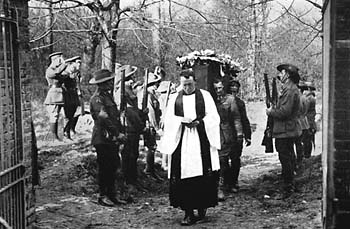 Arriving at the Cemetery : 3 Squadron lays to rest an old adversary, Bertangles Cemetery, France, 22 April 1918 Padre: Reverend George H. Marshall D.S.O., 101 Squadron R.A.F, Photo: Sergeant John Alexander, official 3 Squadron photographer
Nowarra, H. J. and Brown, K. S, von Richthofen and the Flying Circus You may wish to download a 500 pixel or 1000 pixel version of this image
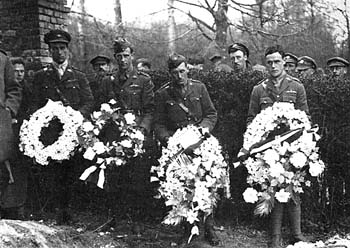 Wreath Bearers : 3 Squadron lays to rest an old adversary, Bertangles Cemetery, France, 22 April 1918 Photo: Sergeant John Alexander, official 3 Squadron photographer L-R: Cptn. T Leigh Simpson, Lieuts. Malcolm Sheehan, Frank Mart and George Pickering
Nowarra, H. J. and Brown, K. S., von Richthofen and the Flying Circus Persons identified ex AWM Negative Number: P00743.039 You may wish to download a 500 pixel or 1000 pixel version of this image
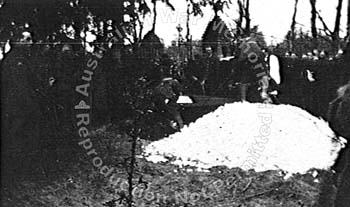 Interrement : 3 Squadron lays to rest an old adversary, Bertangles Cemetery, France, 22 April 1918 Photographer unknown; Australian War Memorial Negative No. P01034.060, Donor S. Clerehan You may wish to download a 500 pixel version of this image
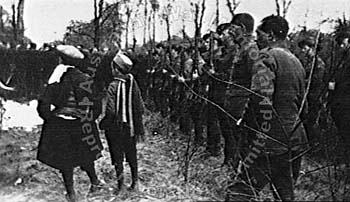 Present Arms : 3 Squadron lays to rest an old adversary, Bertangles Cemetery, France, 22 April 1918 Photographer unknown; Australian War Memorial Negative No. P01034.055, Donor S. Clerehan You may wish to download a 500 pixel version of this image
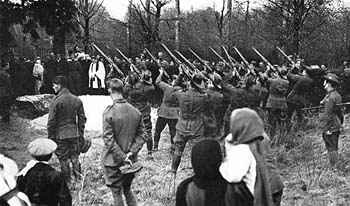 Final salute : 3 Squadron lays to rest an old adversary, Bertangles Cemetery, France, 22 April 1918 Photo: Sergeant John Alexander, official 3 Squadron photographer
Nowarra, H. J. and Brown, K. S., von Richthofen and the Flying Circus You may wish to download a 500 pixel or 1000 pixel version of this image
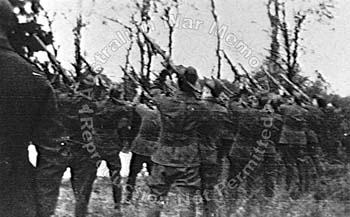 Final salute : 3 Squadron lays to rest an old adversary, Bertangles Cemetery, France, 22 April 1918 Photographer unknown; Australian War Memorial Negative No. P01034.056, Donor S. Clerehan You may wish to download a 500 pixel version of this image
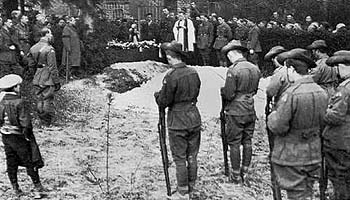 A minutes silence : 3 Squadron lays to rest an old adversary, Bertangles Cemetery, France, 22 April 1918 Photo: Sergeant John Alexander, official 3 Squadron photographer
Nowarra, H. J. and Brown, K. S., von Richthofen and the Flying Circus You may wish to download a 500 pixel or 750 pixel version of this image
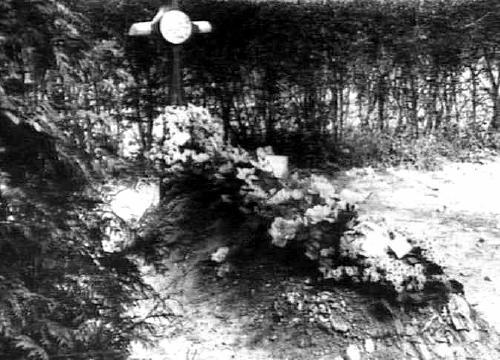 The grave of von Richthofen, Bertangles Cemetery, France, 22 April 1918 Photo: Sergeant John Alexander, official 3 Squadron photographer
Nowarra, H. J. and Brown, K. S., von Richthofen and the Flying Circus You may wish to download a 500 pixel version of this image
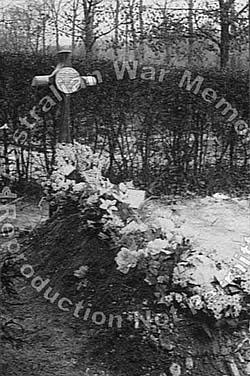 The grave of von Richthofen, Bertangles Cemetery, France, 22 April 1918 Photographer unknown; Australian War Memorial Negative No. H12937, Donor Sister A. Twynam RRC You may wish to download a 350 pixel version of this image
This event is vividly told in the following interview with Harold Edwards, the man who made the plaque shown attached to the cross above Memories of 3 Squadron Australian Flying Corps: An interview with Harold Edwards by Adrian Hellwig http://members.nbci.com/_XMCM/pointcook/afc_articles_cont10.htm Harold Edwards was born on 11 May 1896 at the mining town of Bendigo, Vic., where his father, James Raymond Edwards, had a jewellery shop in Pall Mall, the main street, opposite Roslyn Park and the statue of Queen Victoria. Harold commenced his education at the Central School, completing the sixth grade. Later he was enrolled at St Andrew's College where, amongst other subjects, he very reluctantly studied French. A few years later, serving with the AFC in France, he wished he had put more effort into it. ...more
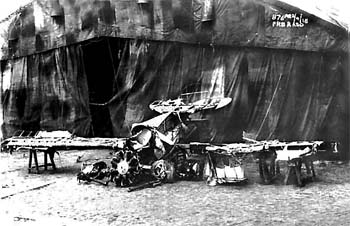 Remains of von Richthofen's triplane on display, April 22, 1918 http://www.geocities.com/aw3aw3/archive.htm Photo: most probably Sergeant John Alexander, official 3 Squadron photographer You may wish to download a 500 pixel version of this image
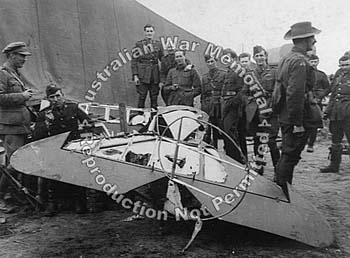 Remains of von Richthofen's triplane on display, April 22, 1918 Australian War Memorial Negative Number: E02044 Identified : Left to right: Lieutenant (Lt) C. W. Gray, observer; Lt F. J. Mart, observer; Lt N. Mulroney, pilot; Lt O. G. Witcomb, observer; Lt T. L. Baillieu, pilot (later awarded DFC); Lt R. W. Kirkwood, observer; Lt A. L. D. Taylor, observer (Killed in action 20 May 1918); Private L. H. Reid, storeman (behind); Lt M. Sheehan, pilot. Photo: most probably Sergeant John Alexander, official 3 Squadron photographer You may wish to download a 500 pixel or 750 pixel version of this image
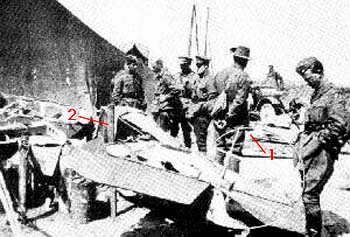 Remains of von Richthofen's triplane on display, April 22, 1918 Note: (1) the still 'curved' rudder frame and (2) still 'present' alumnium seat would seem to indicate that this image was most probably taken earlier than previous image.(Ed.) Photo: most probably Sergeant John Alexander, official 3 Squadron photographer http://members.nbci.com/frontflieger/4-ric18.htm
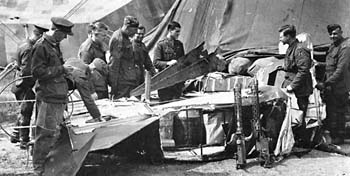 Examining he wreck of von Richthofen's Fokker Triplane, 425/17, April 22, 1918 Photo: most probably Sergeant John Alexander, official 3 Squadron photographer
Nowarra, H. J. and Brown, K. S., von Richthofen and the Flying Circus You may wish to download a 500 pixel or 1000 pixel version of this image
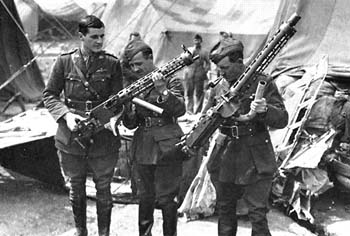 The twin Spandau machine guns from von Richthofen's Fokker Triplane, 425/17, April 22, 1918 Photo: most probably Sergeant John Alexander, official 3 Squadron photographer Nowarra, H. J. and Brown, K. S., von Richthofen and the Flying Circus, Harleyford, UK, 1958, L.C. 58-H941 You may wish to download a 500 pixel or 1000 pixel version of this image
A number of components from von Richthofen's aircraft are now on permanent display at the RAAF Museum at Point Cook in Victoria and at the Australian War Memorial in Canberra.
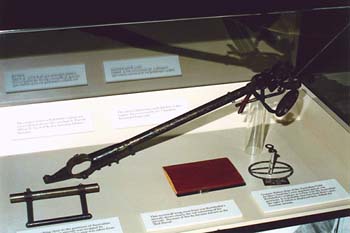 Manfred von Richthofen artifacts at the Australian War Memorial, Canberra From von Richthofen's Triplane, the control column, his compass (not shown), a section of wingstrut, a propeller fragment (not shown), a metal footstep and the gunsights from the anti-aircraft Lewis Gun of Robert Buie (53rd Battery), one of the claimants to delivering the fatal shot Photo: Charles Hart from the website http://pease1.sr.unh.edu/1/Images/index.html You may wish to download a 500 pixel or 1000 pixel version of this image
and in detail...
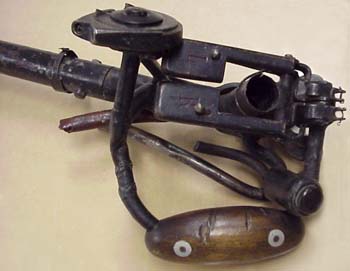 Control column of von Richthofen's Fokker Triplane, 425/17 Australian War Memorial You may wish to download a 500 pixel version of this image
"Within a day of being recovered from its crash site, most of Richthofen' s plane had 'disappeared', leaving little more than a frame. Among the items later handed over to the Australian War Records Section (in this case by Lieutenant W. J. Warneford, the Equipment Officer of 3 Squadron AFC who had salvaged the plane) was the control column. 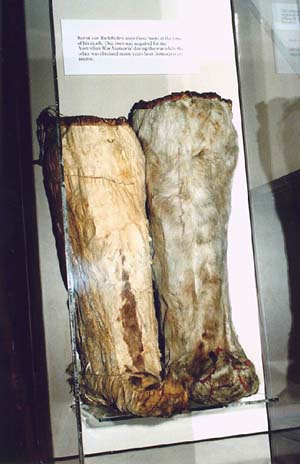 Manfred von Richthofen artifacts at the Australian War Memorial, Canberra von Richthofen's flying boots, only recently paired together Photo: Charles Hart from the website http://pease1.sr.unh.edu/1/Images/index.html You may wish to download a 500 pixel version of this image
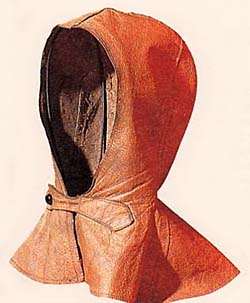 Manfred von Richthofen's flying hood Authenticity unknown but of the period. Image ex 'Webshots' You may wish to download a 350 pixel version of this image
Lieutenant A. S. Patterson, regularly flew as an observer with Captain John R. Duigan. They had many escapes from enemy fighters, but none closer than on May 9, 1918 when they were attacked by four Fokker Triplanes while on a photographic mission over Villers-Bretonneux, France. In the ensuing battle of some minutes, their outgunned reconnaissance aircraft was severly damaged and Captain Duigan, now wounded in five places, was finally forced to land. In Men and Machines of the AFC.. Charles Schaedel mentions this day when he writes about "two (flight commanders) being lost to the squadron (in May) with the death of Captain Ralfe and the wounding of Captain Duigan on the 6th and 9th respectively" Lieutenant Patterson however had been luckier. One bullet had passed through his flying goggles, but he escaped uninjured. The goggles are now on permanent display at the RAAF Museum at Point Cook in Victoria, Australia. The story has even a stanger twist in that despite the battle, the pair had continued to photograph the enemy positions and furthermore on landing, Duigan had refused medical assistance until his observer had been attended to and the photographic plates had been removed from the aircraft's camera and dispatched to base. In late May, Duigan was sent back to England to recover from his wounds and at wars end, took over the command of 7 Training Squadron before returning home to Australia. http://raafmuseum.com.au/tour/artifact/b1.htm Read more about this event
Further Reading In Print Cutlack, Frederick M., The Australian Flying Corps. The Official History of Australia in the War of 1914-1918, Vol. VIII.; University of Queensland Press. St. Lucia, Brisbane. 1923, Reprint 1984
Issacs, Keith, Military Aircraft of Australia 1909-1918, Hammond, David., (illus.) Australian War Memorial, Canberra, 1971 Kilduff, Peter, The Red Baron Combat Wing.; Jagdgeschwader Richthofen in Battle, London. Arms & Armour Press. 1997.
Nowarra, H. J. and Brown, K. S, von Richthofen and the Flying Circus, Harleyford, UK, 1958.
The Death of Manfred von Richthofen : Who fired the fatal shot?
Manfred Freiherr von Richthofen's medical record : Was the "Red Baron" fit to fly?
The Red Fighter Pilot
The Man who killed a Legend
"Final Victory"
The unreliability of the eye witness: the death of von Richthofen Abstract: About 11 o'clock on Sunday morning 21 April 1918 on the Somme, not far from the village of Corbie, a few hundred Allies, mostly Australians, observed an event that suddenly changed from being an everyday sight, a dogfight over the trenches, to a celebrity event that the eyewitnesses could dine out on for the rest of their lives. The catalyst was simply the death of cavalry captain Baron Manfred von Richthofen. I started by saying that it occurred about 11am on Sunday morning 21 April 1918, because that is about the only fact that nobody has argued about (except some people said it was about 10.45 and some said it was ten past eleven). The eyewitnesses differ on almost every point; who shot him down being the most widely discussed, but there are differing views on where he landed, the extent of his wounds and the condition of his plane. The myths have been further elaborated by shoddy research and "creative" reporting. http://www.pcug.org.au/~astaunto/s37.htm#s37von
|
© Copyright 1999-2007 CTIE - All Rights Reserved - Caution |
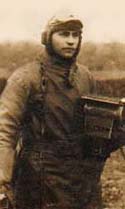 2237 A-Cpl John Arthur Remington Alexander, A.F.C., A.I.F.
2237 A-Cpl John Arthur Remington Alexander, A.F.C., A.I.F.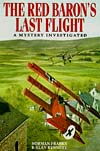 Franks, N., and Bennett Alan, The Red Baron's Last Flight : A Mystery Investigated, Pan Macmillan 1998.
Franks, N., and Bennett Alan, The Red Baron's Last Flight : A Mystery Investigated, Pan Macmillan 1998.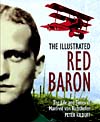 Kilduff, Peter, The Illustrated Red Baron : The Life and Times of Manfred von Richthofen
Kilduff, Peter, The Illustrated Red Baron : The Life and Times of Manfred von Richthofen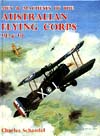 Schaedel, Charles, Men & Machines of the Australian Flying Corps. 1914-19, Dandendong, Vic., Kookaburra Technical Publications. (N.d.).
Schaedel, Charles, Men & Machines of the Australian Flying Corps. 1914-19, Dandendong, Vic., Kookaburra Technical Publications. (N.d.).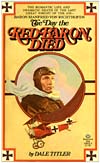 Titler, Dale M., The Day The Red Baron Died. Final Proof that Groundfire Brought von Richthofen Down, Surrey, Ian Allen Ltd., 1973.
Titler, Dale M., The Day The Red Baron Died. Final Proof that Groundfire Brought von Richthofen Down, Surrey, Ian Allen Ltd., 1973.